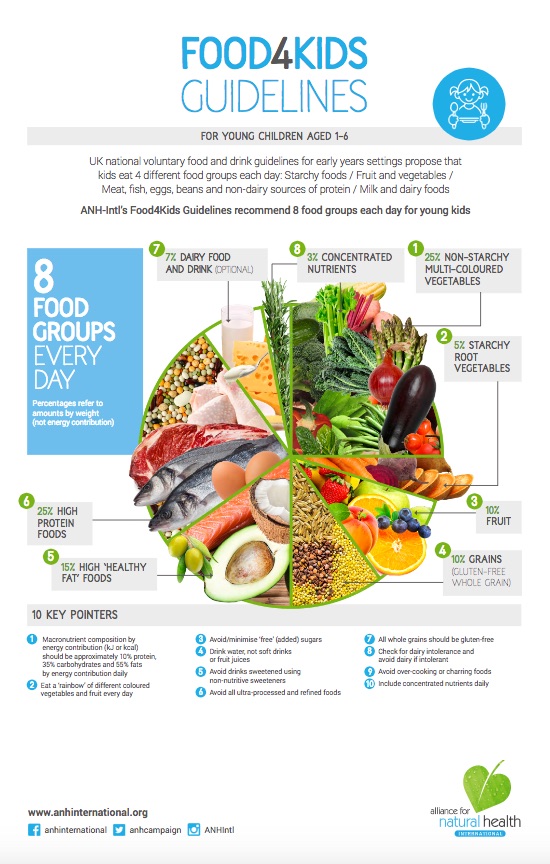By Dr hc Harald Gaier ND DO DHomM DBotM
and Meleni Aldridge, executive coordinator
Last week we launched our Food4Kids guideline with a full breakdown and explanation in the accompanying article Re-thinking what our kids are eating. An important point made by our founder, Rob Verkerk PhD, also the scientist leading the development of the Food4Kids guidelines, was, “Our adult palates, as well as our trajectory of future health, is strongly affected by what and how we eat as children”.
Children copy parents in both good and bad habits. Smoking and alcohol-drinking are perfect examples of this. Tobacco smoke and beer hardly titillate our sweet taste-buds and yet they are often later sought by the offspring of parents who smoked and drank. This tutoring can be both behaviourally and epigenetically communicated. It falls to all adults to persistently lead by example. But with parents ever stretched on time, the temptation to offer sweets and sweetened foods is often too great to resist, especially given their reception from children. It’s quick and convenient to appease and mollify a child’s insistent palate by feeding sweet treats. Giving in to issuing sweet treats, or dumping an infant in front of the television for several hours’ unsupervised viewing, is not about making life better for a child. It’s really about making things easier for the adults or carers, in the short-term, at least. Sweet food should never be offered as a reward. Therein paves the road to future comfort eating which triggers the opioid receptors in our brains that learn to crave for more stimulus. That’s the basis of sugar addiction.
From the age infants are able to have solid foods they need parents and other close family members to persistently keep introducing a wide variety of savoury foods. Then, instead of sweets or sweetened foods, give them fresh fruit, which can be pureed if easier to feed. Dried fruit, raisins, dates, dried mango, banana, or pineapple (all free from sulphur and additives) are other naturally-sweet alternatives, but in moderation only given their high sugar content. Small amounts of dark, cocoa-rich chocolate are also useful alternatives to educate immature palates to bitter, less sweet, tastes.
Last week in our second article The Bitter Truth, we discussed the dumbing down of children’s palates with greasy, salty and sweet foods and drinks. Just as physical activity and outdoor time is essential for a child’s healthy development, so is palate education from a young age. Once children have become used to a narrow range of flavours, overwhelmed by sugar, they are unlikely to take to the taste of whole, unprocessed fruits and vegetables without significant time, effort and education. The 4-year UK National Diet and Nutrition Survey (NDNS) bears testament to the fact that kids in Britain, at least, are sadly reaping the rewards of what they’ve been fed post weaning.
Britain’s ticking childhood time bomb
Alarming statistics show that 1 in 4 children in the UK are obese before they leave primary school. Worse obesity rates can’t be found elsewhere in Europe. This conservatively suggests that in around 15 years or less about half the adult population will be obese and suffering from a plethora of health problems. A simply catastrophic scenario in anyone’s book. Yet rather than seeing a concerted mass effort to reverse the trend, the data on what children are consuming in the UK is even more alarming. Below is a snapshot of the top 20 foods and drinks consumed by 1.5 – 10-year-olds in Britain (based on NDNS data, 2008/2009 – 2011/2012).
Table 1: Top 20 food groups (g/day) consumed by British children under 10 years of age.
Table 2: Average daily intake of selected vitamins and minerals from food sources only of British children (ages 1.5 to 10). Reference Nutrient Intakes (RNI) by age included where available.
In looking at Table 1 the first thing you’ll notice is that protein, essential fats and plant-based phytonutrients are noticeably absent from the first 10 items on the list. Nutrients from those three food groups being responsible for structural development, brain growth and cognitive function, neural health, antioxidant protection and cancer prevention to name just a few. Instead, dairy products, processed beverages (sweetened and low-calorie) and carbohydrates fill the space. In fact, for all age groups under 65 years and over, white bread and pasta, rice, pizza and other miscellaneous cereals were the main contributors to energy intake. Children aged 10 years and under consumed similar quantities of bread, pasta, rice, pizza and cereals, as did adults aged 19 to 64 years! These kinds of starchy, refined carbohydrates are basically another delivery system for glucose and with it, the growth of unfriendly gut bacteria, weight gain and poor blood sugar balance. With their lower body weight, it’s no wonder that children are suffering an obesity crisis. It’s all made worse if kids are not highly active. However, weight management is the tip of the iceberg. This kind of diet, deficient in nutrients (see Table 2) fuels the kind of low-grade inflammation that leads eventually to fatigue, depression and chronic diseases like type 2 diabetes, Alzheimer’s Disease, osteoporosis and cancer.
To add further sugar insults to injury, children under 10 were the highest consumers of fruit juice, but the lowest consumers of salads and raw vegetables. Four to 10-year-olds make up for it by being the highest consumers of chips, fried and roast potatoes and potato products (crisps!) — more sugar. All topped off with puddings, dairy desserts and confectionary – despite the latter not making it to the top 20 list. Chocolate confectionary is consumed by around 60% of children aged 4 to 18 years.
Only 8-12% of British children eat oily fish and that’s probably mainly tinned tuna, which, whilst categorised as oily, has had much of the oil removed in the canning process. Reduced or no consumption of oily fish, combined with children slathered all over with sun block is creating rampant vitamin D deficiency, which represents vital nutrition to support bone and immune health. Whilst white and breaded fish is the most commonly consumed fish in the under 10’s, there just isn’t enough vitamin D it in. This study looked at the link between vitamin D and cardio-metabolic risk factors and found that higher vitamin D, reduced damaging cholesterol in children. With vitamin D deficiency becoming more common it’s imperative that children be exposed to the sun during the summer months and supplemented with oily fish or an omega-3 capsule during the winter months.
Breaking the ‘lemming’ pattern – what can you do?
Unless dietary and physical activity habits are dramatically altered for children they will continue to topple over the obesity and chronic disease cliff like lemmings. Not necessarily of their choosing, but because their food and activity habits are a conditioned and learned response. Firstly, we eat like our parents did and their parents before them, secondly like our friends and peers, unless we are empowered to make conscious changes as free-willed adults. To make matters worse, food peer pressure is alive and well in schools, woe betide the child who brings in something different and healthy for lunch. Matters are made worse by the junk food advertising to kids that has become ubiquitous. Change is going to take a concerted, multi-pronged effort from many different corners in society.
So, for those of you determined to create a leaner, healthier, more vital future for your children, here are some summary points from the Food4Kids guidelines to remember:
- At least 25% of the plate (as a day’s diet) should be composed of a ‘rainbow’ of coloured (red, green, orange, yellow, blue/purple, and white/tan) non-starchy vegetables e.g. broccoli, beans, peppers, tomatoes, aubergines, peas
- Around 5% of the plate is given over to starchy root vegetables e.g. carrots, sweet potato and beetroot
- About 10% is fruit. Limit fruit juices that are a high source of sugar and switch for water or very watered down juice.
- Around 10% of preferably gluten-free whole grains, such as brown rice, quinoa, buckwheat, amaranth, millet or tapioca
- Minimise ‘free’ (added) sugar and avoid non-caloric and artificial sweeteners in foods and beverages
- Healthy fats are essential nutrients that are often completely lacking in a children’s diet. Include 15% healthy fats e.g. oily fish, olive oil, coconut oil, nuts, avocados. Good fats are essential for brain, nerve and motor development so don’t be afraid to include it in your child’s menu – even if you’re resorting to making a chocolate mousse with the avocado!
- Include 25% high protein animal or vegetable foods, such as grass-fed meat, wild-caught fish, or low-lectin legumes
- Dairy products and drinks are optional as there is more and more understood and recognised now about dairy intolerance. Up to 7% of this category if you’re including it.
- Do include as many fresh herbs and spices (3%) as you can and don’t be afraid to supplement with specific nutrients when needed e.g. vitamin D in the winter months or zinc and vitamin C during times of immune challenge.
Download the Food4Kids guidelines, follow them—and stick them on the fridge!











Comments
your voice counts
There are currently no comments on this post.
Your voice counts
We welcome your comments and are very interested in your point of view, but we ask that you keep them relevant to the article, that they be civil and without commercial links. All comments are moderated prior to being published. We reserve the right to edit or not publish comments that we consider abusive or offensive.
There is extra content here from a third party provider. You will be unable to see this content unless you agree to allow Content Cookies. Cookie Preferences